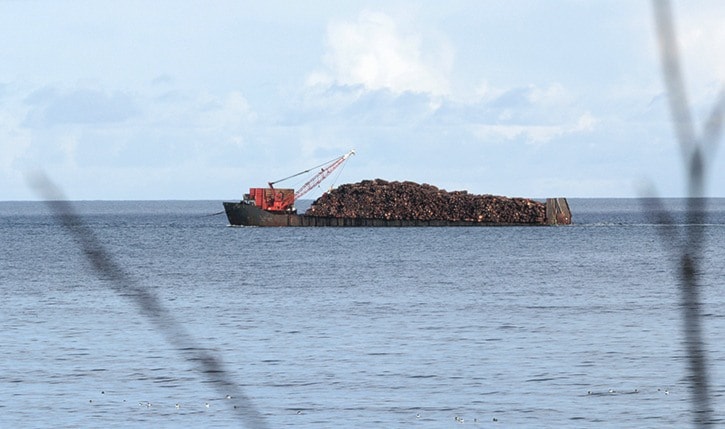Taan Forest can continue hiring small contractors to work on Tree Farm Licence (TFL) 60 after winning a two-year legal battle with the United Steelworkers Union.
The union is appealing the decision.
Writing in a 118-page decision in January, labour arbitrator Stanley Lanyon called the case “unique, complex, and litigious.”
United Steelworkers argued that according to the collective agreement it inherited when it bought TFL 60, Taan Forest could only use one or two “stump to dump” contractors.
“Stump to dump” describes larger contractors with enough workers and machines to handle every phase of logging — from falling and bucking a tree, to yarding or skidding it out of the forest and hauling it to a log sort.
During hearings held last year, witnesses said it could cost $8 to $12 million to equip such a company on Haida Gwaii, which would also need to hire some 50 to 60 workers on a $500,000 monthly payroll.
After the hearings and a review of the 30-year history on TFL 60, which includes 37 per cent of the annual cut on Haida Gwaii, Lanyon ruled in favour of Taan by striking the “stump to dump” rule from the agreement.
First, Lanyon found that in 2002, there was a break in the long chain of ownership over TFL 60 — a break that means Taan is not bound by a related rule requiring the company to hire either a “stump to dump” company or at least 172 full-time workers, the same number MacMillan Bloedel employed on TFL 60 back in 1986.
The 1986 ‘snapshot’ and “stump to dump” rule are common features of union agreements across B.C.’s forestry industry. Both followed long workers’ strikes, one in 1986, the other in 2003.
Not only is Taan not bound by the 1986 rule, Lanyon found the United Steelworkers did nothing to enforce “stump to dump” contracting back when Edwards & Associates was working on TFL 60.
From 2011 to 2014, Edwards hired many subcontractors on TFL 60 — fallers, truckers, log-loaders, hoe-chuckers — and didn’t tell the union.
Given that it was widespread practice for four years, Lanyon found United Steelworkers should have known about Edwards’ subcontracting, and agreed it would be unfair to strictly enforce the same rule for Taan today.
In a separate argument, Lanyon also found the rule violates B.C.’s human rights code in this case.
While intended to protect union jobs, Lanyon found the rule also has the effect of discriminating against the Haida Nation, which owns Taan, and against Haidas who own small-scale forestry businesses.
“The union clearly understands that this prevents the Haida Nation from participating in the harvest of timber on TFL 60, and thereby defeats the express goal of the Haida Nation to rebuild their economy through the vehicle of entrepreneurship in the form of small business — specifically through small phase contractors,” he wrote.
On the human-rights issue, Lanyon heard from Cliff Fregin, chair of HaiCo; Peter Lantin, president of the Haida Nation; and from Haida contractors Nika Collison, Karen Fladmark, and Rick McDonald.
Fregin said that with projected profits of $3.6 million this fiscal year, Taan will provide at least 70 per cent of revenue for HaiCo, the economic development arm of the Haida Nation.
But with an effective $5-million line of credit that is shared by all HaiCo companies, even Taan is not big enough to start an $8 to $12-million “stump to dump” business on Haida Gwaii.
So far, the only companies interested in doing that are Lemare Lake, Husby Forest Products, and Infinity West, none of which are Haida-owned.
While United Steelworkers tried to argue that as indigenous peoples, Haida contractors have more access to financing than the average B.C. citizen, Lanyon found that’s not true.
After reviewing financing options including the Coast Operating Fund, TriCorp, Gwaii Trust, and others, Lanyon found the business loans available to Haida contractors are all in the $30,000 to $40,000 range, with high interest rates of seven to 10 per cent.
Moreover, Lanyon pointed out that under the Indian Act, Haidas living on reserve can’t mortgage property, and that both Skidegate and Old Massett have higher unemployment, lower incomes, and fewer post-secondary graduates than other parts of B.C. — disadvantages that result from Canada’s history of colonialism, displacement, and residential schools.
“This is a case about small, closely-held family businesses, and individuals who are often both shareholder, manager, and employee,” Lanyon wrote.
“This is, in fact, the economic revitalization model for the future that the Haida envision.”
Besides the legal findings about the 1986 rule and the discriminatory effect of “stump to dump,” Lanyon agreed with uncontested testimony from HaiCo CEO Bob Brash, who said that on Haida Gwaii, going with small, single-phase contractors actually makes more business sense.
That’s because the logging areas are far from town and widely dispersed, with some accessible only by boat or for a short season. A single, big company working the same areas would have to have sub-divide into several crews using parallel equipment.
Lanyon concluded there is “no rational reason” why “stump to dump” contractors are needed to harvest TFL 60.
Finally, Lanyon found that although some may be unhappy about it, contractors working for Taan are still bound by the rest of the collective agreement between United Steelworkers and Taan Forest.
“It is only at this point that the parties have a better understanding of their respective rights and obligations under the collective agreement to which they are both subject,” he wrote.
